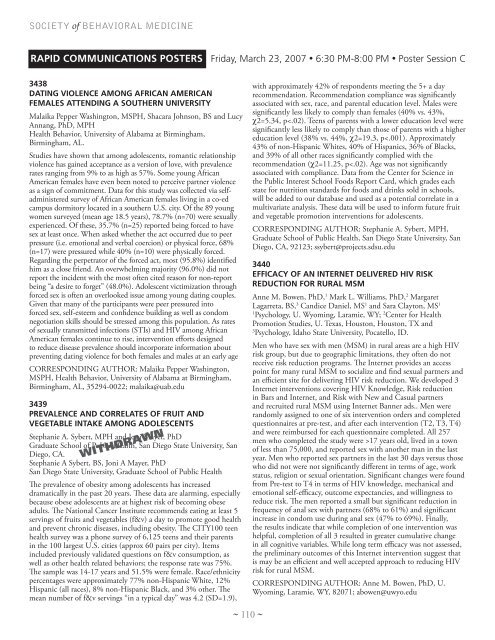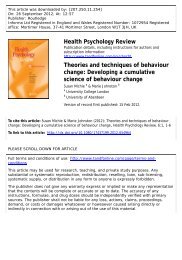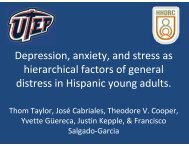2007 Final Program - Society of Behavioral Medicine
2007 Final Program - Society of Behavioral Medicine
2007 Final Program - Society of Behavioral Medicine
You also want an ePaper? Increase the reach of your titles
YUMPU automatically turns print PDFs into web optimized ePapers that Google loves.
SOCIETY <strong>of</strong> BEHAVIORAL MEDICINE<br />
Rapid Communications Posters Friday, March 23, <strong>2007</strong> • 6:30 PM-8:00 PM • Poster Session C<br />
3438<br />
DATING VIOLENCE AMONG AFRICAN AMERICAN<br />
FEMALES ATTENDING A SOUTHERN UNIVERSITY<br />
Malaika Pepper Washington, MSPH, Shacara Johnson, BS and Lucy<br />
Annang, PhD, MPH<br />
Health Behavior, University <strong>of</strong> Alabama at Birmingham,<br />
Birmingham, AL.<br />
Studies have shown that among adolescents, romantic relationship<br />
violence has gained acceptance as a version <strong>of</strong> love, with prevalence<br />
rates ranging from 9% to as high as 57%. Some young African<br />
American females have even been noted to perceive partner violence<br />
as a sign <strong>of</strong> commitment. Data for this study was collected via selfadministered<br />
survey <strong>of</strong> African American females living in a co-ed<br />
campus dormitory located in a southern U.S. city. Of the 89 young<br />
women surveyed (mean age 18.5 years), 78.7% (n=70) were sexually<br />
experienced. Of these, 35.7% (n=25) reported being forced to have<br />
sex at least once. When asked whether the act occurred due to peer<br />
pressure (i.e. emotional and verbal coercion) or physical force, 68%<br />
(n=17) were pressured while 40% (n=10) were physically forced.<br />
Regarding the perpetrator <strong>of</strong> the forced act, most (95.8%) identified<br />
him as a close friend. An overwhelming majority (96.0%) did not<br />
report the incident with the most <strong>of</strong>ten cited reason for non-report<br />
being “a desire to forget” (48.0%). Adolescent victimization through<br />
forced sex is <strong>of</strong>ten an overlooked issue among young dating couples.<br />
Given that many <strong>of</strong> the participants were peer pressured into<br />
forced sex, self-esteem and confidence building as well as condom<br />
negotiation skills should be stressed among this population. As rates<br />
<strong>of</strong> sexually transmitted infections (STIs) and HIV among African<br />
American females continue to rise, intervention efforts designed<br />
to reduce disease prevalence should incorporate information about<br />
preventing dating violence for both females and males at an early age<br />
CORRESPONDING AUTHOR: Malaika Pepper Washington,<br />
MSPH, Health Behavior, University <strong>of</strong> Alabama at Birmingham,<br />
Birmingham, AL, 35294-0022; malaika@uab.edu<br />
3439<br />
PREVALENCE AND CORRELATES OF FRUIT AND<br />
VEGETABLE INTAKE AMONG ADOLESCENTS<br />
Stephanie A. Sybert, MPH and Joni Mayer, PhD<br />
Graduate School <strong>of</strong> Public Health, San Diego State University, San<br />
Diego, CA.<br />
Stephanie A Sybert, BS, Joni A Mayer, PhD<br />
San Diego State University, Graduate School <strong>of</strong> Public Health<br />
WITHDRAWN<br />
The prevalence <strong>of</strong> obesity among adolescents has increased<br />
dramatically in the past 20 years. These data are alarming, especially<br />
because obese adolescents are at highest risk <strong>of</strong> becoming obese<br />
adults. The National Cancer Institute recommends eating at least 5<br />
servings <strong>of</strong> fruits and vegetables (f&v) a day to promote good health<br />
and prevent chronic diseases, including obesity. The CITY100 teen<br />
health survey was a phone survey <strong>of</strong> 6,125 teens and their parents<br />
in the 100 largest U.S. cities (approx 60 pairs per city). Items<br />
included previously validated questions on f&v consumption, as<br />
well as other health related behaviors; the response rate was 75%.<br />
The sample was 14-17 years and 51.5% were female. Race/ethnicity<br />
percentages were approximately 77% non-Hispanic White, 12%<br />
Hispanic (all races), 8% non-Hispanic Black, and 3% other. The<br />
mean number <strong>of</strong> f&v servings “in a typical day” was 4.2 (SD=1.9),<br />
~ 110 ~<br />
with approximately 42% <strong>of</strong> respondents meeting the 5+ a day<br />
recommendation. Recommendation compliance was significantly<br />
associated with sex, race, and parental education level. Males were<br />
significantly less likely to comply than females (40% vs. 43%,<br />
χ2=5.34, p

















